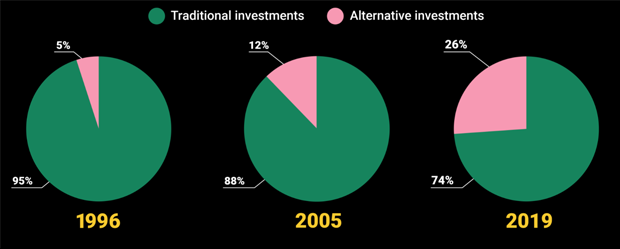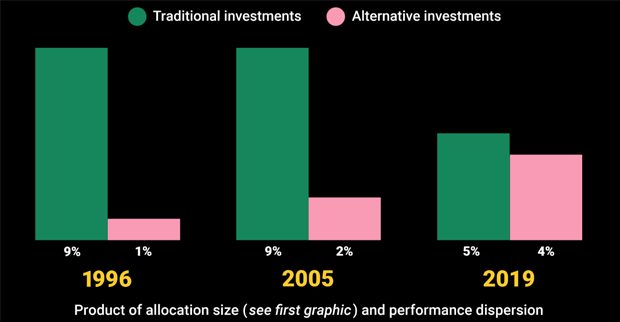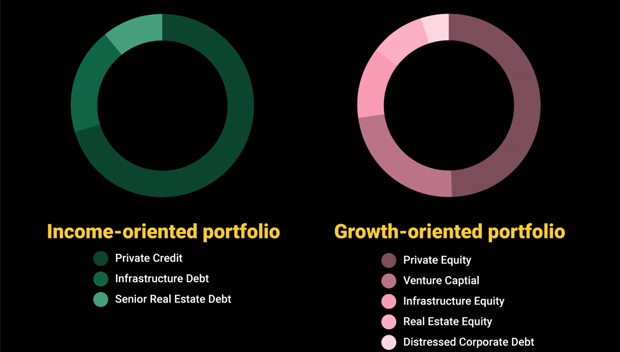Capital at risk. All financial investments involve an element of risk. Therefore, the value of the investment and the income from it will vary and the initial investment amount cannot be guaranteed.
Mission critical
People in finance often observe that “alternative” investments — so called because of the niche role they once played for investors — need a new name.
Over the past 25 years or so, alternatives have evolved from a small part of the portfolios of the world’s largest investors into a core holding. As the graphic below shows, alternative investments — which include non-traditional asset classes such as private equity, private credit, real estate, infrastructure and more — represented just 5 percent of global pension portfolios in 1996. In 2019, they accounted for more than 25 percent.
More alternatives in pension portfolios

For these institutions, and the people who depend on them, this is a major development. At many pension funds, the performance of alternative investments now has a significant impact on the fund’s ability to keep its promises to the firefighters or teachers it serves. “It’s a mission-critical role, which raises an important question,” says Edwin Conway, Global Head of Equity Private Markets. “Given that these investments are often more complex than traditional ones, how do you develop the insights needed for good investment decisions and effective portfolio management?”
What’s driving the change
The growing prominence of alternative investments — most of which are private, as opposed to publicly listed stocks and bonds — reflects changes that have been underway in financial markets for decades. The population of public companies in the United States, for example, has declined nearly 40 percent since 1988, while the number of private companies with 500 or more employees has grown more than 50 percent. That gives investors looking to benefit from corporate growth a good reason to invest in private as well as public equity.
Different investors have embraced alternatives to different degrees (insurers tend to own less, while endowments tend to own more) and for different sets of reasons. But the biggest motivation is the simplest: Investors need attractive risk-adjusted returns, ideally diversified away from the public markets. That may be particularly true now, as the bull market in equities enters its 11th year and investors wonder how long it can be sustained.
But if alternatives offer a potential premium to traditional investments, the premium comes with its own set of challenges. For one thing, the sustained popularity of alternatives has elevated prices in many segments of the market, making a disciplined approach to investing in them more important than ever.
Given that these investments are often more complex than traditional ones, how do you develop the insights needed for good investment decisions and effective portfolio management?
Investors also need to take account of the multi-year time periods of investments such as private equity and infrastructure. It makes sense for long-term investors like pension funds to tie up a portion of their money in exchange for appropriate compensation, but managing liquidity needs and maintaining holdings at desired levels is inevitably more complicated than it is with stocks and bonds.
There’s no shortage of decisions to be made.
“With alts you have to get two things right,” says Pam Chan, CFA, who invests across the spectrum of alternatives as global head and C.I.O. of BlackRock Alternative Solutions. “First, top-down, what part of the alternative investment landscape do you want to invest in? Is it private equity, private credit, infrastructure, real estate or other niche private market asset classes? Where is there relative value, and how does a given investment help you achieve your specific goal?”
“Second, there’s the question of who you want to invest with and how they ‘manufacture’ investments bottom-up,” Chan adds. “There’s historically a much bigger difference between the top performers and the bottom ones within the private markets than in public markets.”
Given this wider range of potential results, a dollar invested in alternatives has a higher marginal impact on portfolio performance than a dollar invested in public markets. Indeed, an average pension fund with 26 percent of its portfolio in alternatives may see that slice influence overall results nearly as much as the 74 percent in public market investments. See the graphic below.
A higher marginal impact on portfolio performance

“Performance dispersion” is the industry’s term for some managers doing better than others, and it’s not hard to see why there’s more dispersion in alternative investing. “Given the complexity inherent in alternative investments,” Barry explains, “there’s more for managers to get right — or wrong.” This greater challenge, and the skills and resources needed to navigate it, is often seen as the main reason why private assets potentially offer a return premium over public ones.
Not least among the necessary skills and resources is the ability to look beneath the hood and understand the mechanics that drive these investments. Public markets are brimming with data. Just turn on CNBC and you’ll get an earful. Information in private markets is (no surprise) harder to come by, yet no less essential for good decision-making. Investors need visibility on the risks each investment entails, on whether the potential returns are commensurate with those risks and on how much those risks overlap with the ones posed by other investments in the portfolio.
So what’s the goal here?
As investors increase their holdings of alternative investments, they are demanding more information so they can evaluate them independently and integrate them within their portfolios. And while they retain their interest in higher returns, they are also thinking about the other things alternatives can do for their portfolios.
Diversification, always a key benefit, is probably becoming an even more important motivation. At a time when public markets are growing more volatile, the fact that alternatives don’t move up and down in lockstep with stocks or bonds is an attractive feature.
At the same time, a larger and more varied roster of alternative investments makes it possible for investors to choose the ones that will help them achieve the specific goal they’re pursuing without taking on more risk than they need to. While some investors are focused almost entirely on growth, many others need a mix of growth and income and, often, a hedge against inflation. Today’s expanded alternatives lineup offers choices to target all of the above. The graphic below shows how a hypothetical portfolio designed to seek income might differ from one designed to seek growth.
It's all in the mix

Fitting in
With alternatives making up a greater share of the portfolio and linking more directly to the investor’s overall objectives, it becomes increasingly important to scrutinize them side by side with traditional investments. “When people think about investing, they've traditionally thought about investing in equities, investing in bonds, investing in alternatives,” says Mark Everitt, CFA, the head of investment research and strategy for BlackRock Alternative Investors. “But more and more, alternatives can be considered as part of your general equity allocation or your general credit allocation in the bond part of your portfolio.”
What does it take to accomplish this? Above all, more visibility on the underlying sources of risk and return in alternatives. “Better data, and the ability to analyze it, are a major part of our focus here at BlackRock,” says Everitt. “We’ve brought a lot of clarity and ease of use to public markets, and we’re now doing the same in private markets. It’s what our clients need.”
Financial markets are always evolving, and alternatives are no exception. “Growing pains are inevitable,” Conway says, “and it’s important for investors to think of the next decade as well as the next economic cycle.”
Over that time period, these investments are likely to see a steady expansion of the role they play in portfolios as well as in the broader economy. They might even get a new name. It’s already several years overdue.



